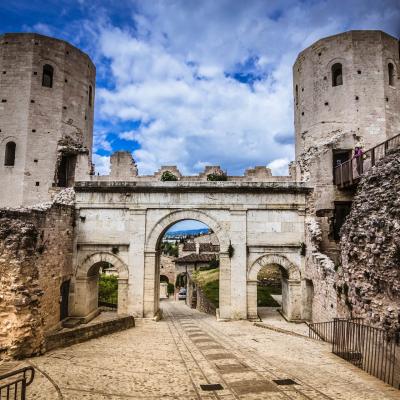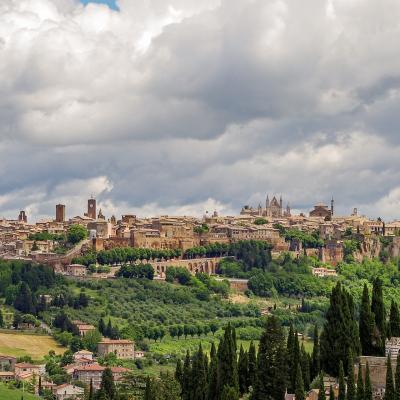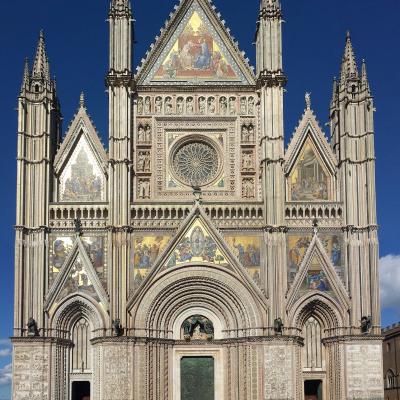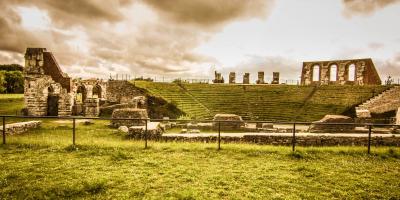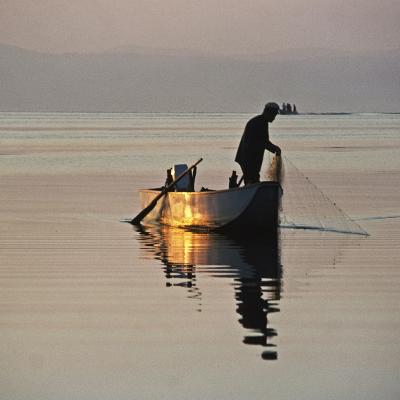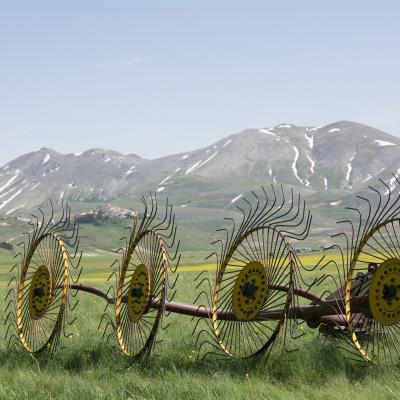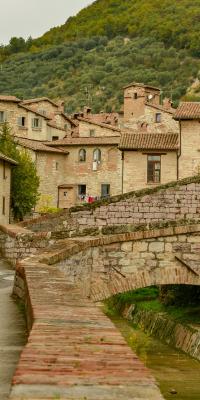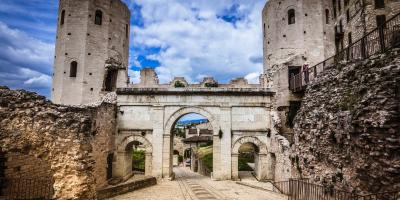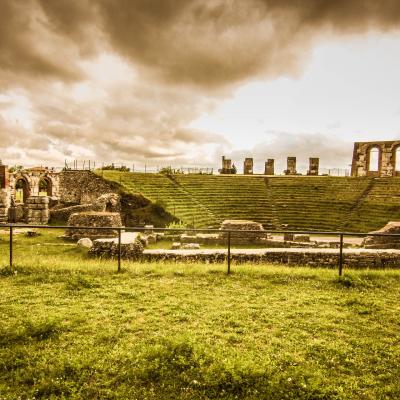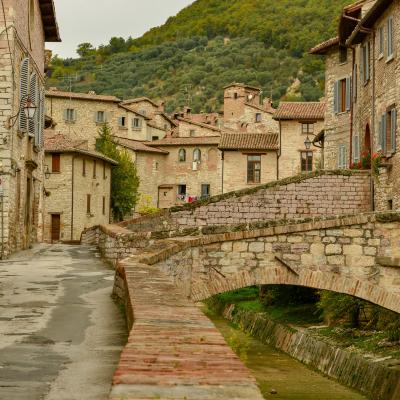Umbria
Umbria represents "the green heart of Italy" and is the only landlocked region. Among green hills and medieval villages, it has a rich food and wine culture and one of the most important artistic heritages on the peninsula. Seventy-one percent of the territory is characterized by hills, mountains, and winding valleys that extend over the Tiber basin. Here one enjoys a spiritual landscape, with the colors of the hills, woods and sunsets inviting meditation (let us not forget that Umbria is the land of St. Francis). One is immersed in a nature that has been well preserved, thanks to a harmonious relationship with lifestyles that is difficult to find elsewhere, in Italy and beyond.
Umbria is placed in the center of the Italian peninsula, it refers to an image of peace and tranquility, of landscapes connoted by the medieval imprint of refined simplicity. It is the only peninsular region that is not washed by the sea, but presents a varied and multiform landscape, but the most typical character of the region is given by the high hills, only a very small portion of the Umbrian territory is flat while the rest is mainly hilly and mountainous, rich in vegetation for which it is called "the green heart of Italy". Between the mountains and hills are the Valle Umbra between Perugia and Spoleto and the Tiberina valley traversed by a section of the Tiber River. The landscape is rich in water: springs such as those of Clitunno, the Marmore Falls, Lake Trasimeno and Lake Piediluco.
Umbria has a richhistoric and artistic heritage of which we find evidence in its splendid cities, a visit to Perugia, for example, is not to be missed. But also smaller cities such as Todi, Gubbio, Spoleto, Foligno or Città della Pieve that with their monuments narrate the history and spirituality of these places. Umbria is also a destination for religious tourism, numerous are the tourists who flock every year to cities such as Assisi with its world-famous basilica.
Umbria is also the region of Lake Trasimeno, the largest in central Italy, in whose territory are the remains of Etruscan settlements. Near Terni are the famous Marmore Falls, considered among the most beautiful in Europe. Among the pearls of the region stands Assisi, one of the most important centers of Christianity for being the birthplace of St. Francis (patron saint of Italy) and St. Clare. It is part of the UNESCO World Heritage Site. In Orvieto is the Duomo, with one of the most beautiful facades in Italy and splendid frescoes by Luca Signorelli, not to mention the legendary St. Patrick's Well. Perugia, the region's capital, has a 14th-century historic center that has earned it the title of one of Italy's most beautiful villages. Despite this, it has always been an innovative city: it was the first Italian city to build escalators at several points in the city so people could walk to the center. Gubbio is the oldest city in Umbria: the cathedral, the Palazzo dei Consoli as the symbol of the city and the Ducal Palace are just some of the monuments that make it so unique.
Few regions like Umbria are capable of arousing such intense emotions. All the souls of this land interpenetrate perfectly. For lovers of nature, trekking, walking and outdoor activities there is an embarrassment of riches, among no less than seven regional natural parks. Those who prefer downhill skiing, on the other hand, have fifteen kilometers of slopes of varying difficulty at Forca Canapina di Norcia. The Marmore Falls attract many visitors not only for the spectacular nature of its waters, but also for being able to practice canoeing, kayaking and for the various itineraries to discover the area dedicated to children. Those seeking a more peaceful relationship with nature find the WWF oasis of Alviano a prime location for birdwatching and and orienteering, a fun activity for exploring the forest and natural environment. Another fascinating route is the Via Francigena of St. Francis: to be traveled on foot, it puts us in contact with boundless landscapes, in an intimist dimension on the one hand and of conviviality with other pilgrims on the other.
Assisi
The city of Assisi sits on a rocky outcrop of Mount Subasio; in 1181 St. Francis was born there. The city is entirely surrounded by walls, the main entrance being Porta San Francesco, which leads into the ancient town.
The Basilica of St. Francis, probably designed by Friar Elia, was built from 1228 and consists of two churches one lower and one upper.
In the lower one interesting are the chapel of St. Catherine frescoed by Andrea da Bologna, in the nave are preserved frescoes by the Master of St. Francis and the Coronation of Mary of the Giotto school.
The crypt below preserves the body of St. Francis. The chapel of St. Martin has frescoes by Simone Martini with Saints and stories from the life of St. Martin the walls and vault of the right transept are covered with frescoes with stories of St. Francis by Giotto and the Madonna and Child, Angels and St. Francis by Cimabue.
In the left transept are Scenes from the Passion By Pietro Lorenzetti, the Crucifixion, the Madonna and Child with Saints Francis and John, the Descent from the Cross and the Deposition in the Tomb, also by Pietro Lorenzetti.
The single-nave upper church contains frescoes by Cimabue and Giotto with Scenes from the Old and New Testaments and 28 frescoes that life of St. Francis.
St. Francis Street is overlooked by the house of the Comacini masters, the Vallemanni palace and the pilgrims' oratory.
In Piazza del Comune face the Palazzo del Capitano del popolo, the Torre del popolo, the temple of Minerva, and the Palazzo di Priori where the municipal art gallery is housed.
Mountain
Umbrian mountain ranges never exceed 1,500 meters in elevation, they are part of the central Apennine mountain range in the section called Umbria-Marches, the major peaks being the Sibillini Mountains and Terminillo on the border with Lazio. The vast presence of mountains, ensures the possibility of practicing throughout the year many sports such as rock climbing, mountaineering, skiing and mountain biking.
In some places alpine skiing is practiced for example in Forca Canapine, on the Mount Vettore Massif in the Sibillini Mountains National Park, while cross-country skiing is practiced in the areas ranging from the Vettore and the Pian delle Macinare area in the Mount Cucco Massif Regional Park.
The Parks
The Trasimeno Lake Park is an ideal tourist destination for those who want to spend a relaxing vacation immersed in nature but without neglecting the artistic, cultural and gastronomic aspects that the area offers. Lake Trasimeno is one of the largest basins in peninsular Italy.
Many are the parks in the region: Mount Cucco Park, Mount Subasio Park, Colfiorito Park, Tiber River Park, Nera River Park to these should be added the Monti Sibillini National Park that is shared with the region of Marche.
What to eat
The cuisine of Umbria has a distinctly peasant vocation, thanks to the use of quality raw materials and basic ingredients. Renowned is the selection of pastas and soups: strangozzi di Spoleto topped with trout and truffle, manfrigoli di farro, and pasticcio di Jacopone di Todi, a giant raviolo cut into slices and served with meat sauce. In Norcia, of course, pastas are prepared with black truffles, considered among the most prized internationally; white truffles can also be found, especially in the Orvieto and Gubbio areas. As a second course, try roast goose, stuffed duck and the much-loved pork, from which the amazing porchetta is made. All should be accompanied by polenta, prepared with mushrooms or with guanciale and pecorino cheese, a sort of carbonara. Delicious are Pecorino cheese, slightly spicy and savory, and Norcia ham, to be enjoyed with sciapo bread that enhances the flavor.
The waterways and Lake Trasimeno yield fine fish: in Spoleto, the Nera trout with truffles is beloved, as is the Trasimeno tegamaccio, a tasty brodetto. Castelluccio di Norcia lentils have been granted PGI (protected geographical indication) status by the European Union. In addition, Umbria produces an extra-virgin olive oil of absolute excellence: golden and fruity, it enriches every dish without covering its flavor, achieving a level of quality that has earned it DOP (protected designation of origin) status. As for desserts, there are recipes that have been handed down for centuries: for example, torcolo (aniseed doughnut with candied fruit and raisins), zuccherini di Bettona and gingerbread. The Umbrian soil is particularly suitable for viticulture, and the temperate climate has enabled this land to produce fine white and red DOC wines, including Grechetto di Assisi, Verdello, Sagrantino di Montefalco and Orvieto, one of the most famous whites in Italy.
